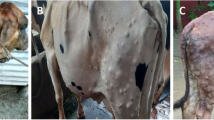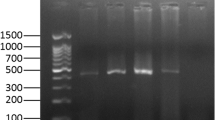Abstract
Lumpy skin disease (LSD) is a contagious viral transboundary disease listed as a notifiable disease by the World Organization of Animal Health (WOAH). The first case of this disease was reported in Pakistan in late 2021. Since then, numerous outbreaks have been documented in various regions and provinces across the country. The current study primarily aimed to analyze samples collected during LSD outbreaks in cattle populations in the Sindh and Punjab provinces of Pakistan. Phylogenetic analysis was conducted using partial sequences of the GPCR, p32, and RP030 genes. Collectively, the LSDV strains originating from outbreaks in Pakistan exhibited a noticeable clustering pattern with LSDV strains reported in African, Middle Eastern, and Asian countries, including Egypt, the Kingdom of Saudi Arabia, India, China, and Thailand. The precise reasons behind the origin of the virus strain and its subsequent spread to Pakistan remain unknown. This underscores the need for further investigations into outbreaks across the country. The findings of the current study can contribute to the establishment of effective disease control strategies, including the implementation of a mass vaccination campaign in disease-endemic countries such as Pakistan.


Similar content being viewed by others
Data availability
The assembled sequences have been submitted to the GenBank database (accession no. OP807837-57).
References
McInnes CJ, Damon IK, Smith GL et al (2023) ICTV Virus Taxonomy Profile: Poxviridae 2023. J Gen Virol 104(5):001849. https://doi.org/10.1099/jgv.0.001849
Annandale CH, Irons PC, Bagla VP et al (2010) Sites of persistence of lumpy skin disease virus in the genital tract of experimentally infected bulls. Reprod Domest Anim 45(2):250–255. https://doi.org/10.1111/j.1439-0531.2008.01274.x
Bianchini J, Simons X, Humblet MF et al (2023) Lumpy skin disease: a systematic review of mode of transmission, risk of emergence and risk entry pathway. Viruses 15(8):1622. https://doi.org/10.3390/v15081622
Tuppurainen ES, Lubinga JC, Stoltsz WH et al (2013) Mechanical transmission of lumpy skin disease virus by Rhipicephalus appendiculatus male ticks. Epidemiol Infect 141(2):425–430. https://doi.org/10.1017/S0950268812000805
Gelaye E, Lamien CE (2019) Lumpy skin disease and vectors of LSDV. In: Kardjadj M, Diallo A, Lancelot R (eds) Transboundary animal diseases in Sahelian Africa and connected regions. Springer, Cham, pp 267–288. https://doi.org/10.1007/978-3-030-25385-1_13
Paslaru AI, Maurer LM, Vögtlin A et al (2022) Putative roles of mosquitoes (Culicidae) and biting midges (Culicoides spp.) as mechanical or biological vectors of lumpy skin disease virus. Med Vet Entomol 36(3):381–389. https://doi.org/10.1111/mve.12576
Tuppurainen ES, Oura CA (2012) Lumpy skin disease: an emerging threat to Europe, the Middle East and Asia. Transbound Emerg Dis 59(1):40–48. https://doi.org/10.1111/j.1865-1682.2011.01242.x
Pestova Y, Byadovskaya O, Kononov A, Sprygin A (2018) A real time high-resolution melting PCR assay for detection and differentiation among sheep pox virus, goat pox virus, field and vaccine strains of lumpy skin disease virus. Mol Cell Probes 41:57–60. https://doi.org/10.1016/j.mcp.2018.08.003
Sudhakar SB, Mishra N, Kalaiyarasu S et al (2020) Lumpy skin disease (LSD) outbreaks in cattle in Odisha state, India in August 2019: Epidemiological features and molecular studies. Transbound Emerg Dis 67(6):2408–2422. https://doi.org/10.1111/tbed.13579
Ul-Rahman A, Niaz N, Raza MA et al (2022) First emergence of lumpy skin disease in cattle in Pakistan. Transbound Emerg Dis 69(6):3150–3152. https://doi.org/10.1111/tbed.14742
Ul-Rahman A, Shahid MF, Iqbal MZ et al (2023) Evaluation of haematological, serum biochemical and oxidative stress parameters in cattle naturally infected with lumpy skin disease virus. Trop Anim Health Prod 55(3):184. https://doi.org/10.1007/s11250-023-03608-1
Khatri G, Rai A, Aashish S et al (2023) Epidemic of lumpy skin disease in Pakistan. Vet Med Sci 9(2):982–984. https://doi.org/10.1002/vms3.1037
Rouby SR (2018) RPO30 gene based PCR for detection and differentiation of lumpy skin disease virus and sheep poxvirus field and vaccinal strains. Vet Sci Res Rev 4(1):1–8. https://doi.org/10.17582/journal.vsrr/2018.4.1.1.8
Timurkan MÖ, Özkaraca M, Aydın H, Sağlam YS (2016) The detection and molecular characterization of lumpy skin disease virus, northeast turkey. Int J Vet Sci 5(1):44–47
Hall TA (1999) BioEdit: a user-friendly biological sequence alignment editor and analysis program for Windows 95/98/NT. Nucleic Acids Symp Ser 41:95–98
Tamura K, Stecher G, Peterson D et al (2013) MEGA6: molecular evolutionary genetics analysis version 6.0. Mol Biol Evol 30:2725–2729. https://doi.org/10.1093/molbev/mst197
Babiuk S, Bowden TR, Parkyn G et al (2008) Quantification of lumpy skin disease virus following experimental infection in cattle. Transbound Emerg Dis 55(7):299–307. https://doi.org/10.1111/j.1865-1682.2008.01024.x
Aleksandr K, Pavel P, Olga B et al (2020) Emergence of a new lumpy skin disease virus variant in Kurgan Oblast, Russia, in 2018. Arch Virol 165(6):1343–1356. https://doi.org/10.1007/s00705-020-04607-5
Ochwo S, VanderWaal K, Ndekezi C et al (2020) Molecular detection and phylogenetic analysis of lumpy skin disease virus from outbreaks in Uganda 2017–2018. BMC Vet Res 16(1):66. https://doi.org/10.1186/s12917-020-02288-5
Wang J, Xu Z, Wang Z et al (2022) Isolation, identification and phylogenetic analysis of lumpy skin disease virus strain of outbreak in Guangdong, China. Transbound Emerg Dis 69(5):e2291–e2301. https://doi.org/10.1111/tbed.14570
Ma J, Yuan Y, Shao J et al (2021) Genomic characterization of lumpy skin disease virus in southern China. Transbound Emerg Dis 69(5):2788–2799. https://doi.org/10.1111/tbed.14432
Selim A, Manaa E, Khater H (2021) Molecular characterization and phylogenetic analysis of lumpy skin disease in Egypt. Comp Immunol Microbiol Infect Dis 79:101699. https://doi.org/10.1016/j.cimid.2021.101699
Şevik M, Doğan M (2017) Epidemiological and molecular studies on lumpy skin disease outbreaks in Turkey during 2014–2015. Transbound Emerg Dis 64(4):1268–1279. https://doi.org/10.1111/tbed.12501
Kumar N, Chander Y, Kumar R et al (2021) Isolation and characterization of lumpy skin disease virus from cattle in India. PLoS One 16(1):e0241022. https://doi.org/10.1371/journal.pone.0241022
Maw MT, Khin MM, Hadrill D et al (2022) First report of lumpy skin disease in Myanmar and molecular analysis of the field virus isolates. Microorganisms 10(5):897. https://doi.org/10.3390/microorganisms10050897
Tulman ER, Afonso CL, Lu Z et al (2001) Genome of lumpy skin disease virus. J Virol 75(15):7122–7130. https://doi.org/10.1128/jvi.75.15.7122-7130.2
Klement E, Broglia A, Antoniou SE et al (2020) Neethling vaccine proved highly effective in controlling lumpy skin disease epidemics in the Balkans. Prev Vet Med 181:104595. https://doi.org/10.1016/j.prevetmed.2018.12.001
Wolff J, Moritz T, Schlottau K et al (2020) Development of a safe and highly efficient inactivated vaccine candidate against lumpy skin disease virus. Vaccines 9(1):4. https://doi.org/10.3390/vaccines9010004
Hasib FM, Islam MS, Das T et al (2021) Lumpy skin disease outbreak in cattle population of Chattogram, Bangladesh. Vet Med Sci 7(5):1616–1624. https://doi.org/10.1002/vms3.524
Sudhakar SB, Mishra N, Kalaiyarasu S et al (2022) Genetic and phylogenetic analysis of lumpy skin disease viruses (LSDV) isolated from the first and subsequent field outbreaks in India during 2019 reveals close proximity with unique signatures of historical Kenyan NI-2490/Kenya/KSGP-like field strains. Transbound Emerg Dis 69(4):e451–e462. https://doi.org/10.1111/tbed.14322
Sprygin A, Pestova Y, Wallace DB et al (2019) Transmission of lumpy skin disease virus: a short review. Virus Res 269:197637. https://doi.org/10.1016/j.virusres.2019.05.015
Tuppurainen ES, Stoltsz WH, Troskie M et al (2011) A potential role for ixodid (hard) tick vectors in the transmission of lumpy skin disease virus in cattle. Transbound Emerg Dis 58(2):93–104. https://doi.org/10.1111/j.1865-1682.2010.01184.x
Sohier C, Haegeman A, Mostin L et al (2019) Experimental evidence of mechanical lumpy skin disease virus transmission by Stomoxys calcitrans biting flies and Haematopota spp. horseflies. Sci Rep 9(1):20076. https://doi.org/10.1038/s41598-019-56605-6
Mafirakureva P, Saidi B, Mbanga J (2017) Incidence and molecular characterisation of lumpy skin disease virus in Zimbabwe using the P32 gene. Trop Anim Health Prod 49(1):47–54. https://doi.org/10.1007/s11250-016-1156-9
Mansour KA (2017) Phylogenetic tree analysis study of Lumpy skin disease virus based envelope protein P32 gene in Al-Qadisiyah Province, Iraq. Al-Qadisiyah J Vet Med Sci 16(1):106–111
Rashid PM, Baba Sheikh MO, Raheem ZH, Marouf AS (2017) Molecular characterisation of lumpy skin disease virus and sheeppox virus based on p32 gene. Bulg J Vet Med 20(2):131–140. https://doi.org/10.15547/bjvm.984
Hedayati Z, Varshovi HR, Mohammadi A, Tabatabaei M (2021) Molecular characterization of lumpy skin disease virus in Iran (2014–2018). Arch Virol 166(8):2279–2283. https://doi.org/10.1007/s00705-021-05119-6
Lu G, Xie J, Luo J et al (2021) Lumpy skin disease outbreaks in China, since 3 August 2019. Transbound Emerg Dis 68(2):216–219. https://doi.org/10.1111/tbed.13898
Acknowledgments
The authors would like to thank the veterinary field staff and Livestock & Dairy Development Department Pakistan, for their support during sample collection.
Funding
None.
Author information
Authors and Affiliations
Contributions
Manzoor S, Abubakar M, and Afzal M conceived the study; Abubakar M, Syed Z, and Ahmad K collected data from field outbreaks; Ul-Rahman A did data analysis; and Manzoor S, Abubakar M, and Ul-Rahman A wrote the manuscript and edited the final draft.
Corresponding authors
Ethics declarations
Conflict of interest
The authors declare that they have no conflict of interest.
Ethical approval
This article does not contain any studies with human participants or animals performed by any of the authors.
Additional information
Handling Editor: William G. Dundon.
Publisher's Note
Springer Nature remains neutral with regard to jurisdictional claims in published maps and institutional affiliations.
Supplementary Information
Below is the link to the electronic supplementary material.
Rights and permissions
Springer Nature or its licensor (e.g. a society or other partner) holds exclusive rights to this article under a publishing agreement with the author(s) or other rightsholder(s); author self-archiving of the accepted manuscript version of this article is solely governed by the terms of such publishing agreement and applicable law.
About this article
Cite this article
Manzoor, S., Abubakar, M., Ul-Rahman, A. et al. Molecular characterization of lumpy skin disease virus from recent outbreaks in Pakistan. Arch Virol 168, 297 (2023). https://doi.org/10.1007/s00705-023-05925-0
Received:
Accepted:
Published:
DOI: https://doi.org/10.1007/s00705-023-05925-0




